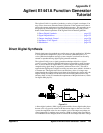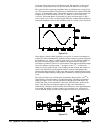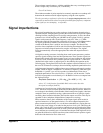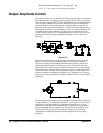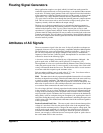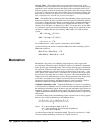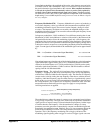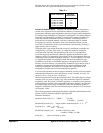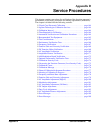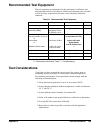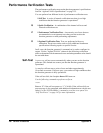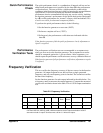
160 Agilent E1441A Function Generator Tutorial
Appendix C
from the front-panel Ext Trig terminal or from BUS triggers.
A sine wave sweep from 50 Hz to 5 kHz with linear 1 second sweep time.
Frequency Shift Key Modulation In Frequency-Shift Keying modulation (FSK),
the function generator's output frequency alternates between the carrier frequency
and a second “hop” frequency. The rate of frequency hops is controlled either by an
internal source or from an external logic input.
FSK is essentially a special case of
frequency modulation (
FM) where the hop frequency is another way of specifying
both the deviation and the modulating signal shape.
The modulating signal shape is always a square wave with an amplitude of zero to
+1. The deviation is either positive or negative depending on whether the hop
frequency is larger or smaller than the present carrier frequency (as shown below).
The internal
FSK rate generator specifies the period of the modulating square wave
signal. When selected, the external
FSK input replaces the internal FSK rate generator
to directly control the frequency hop rate. A
TTL “low” input always selects the
carrier frequency and a
TTL “high” always selects the hop frequency. The logic sense
of the external
FSK input can effectively be changed by interchanging the carrier and
hop frequency values.
Deviation = Hop Frequency – Carrier Frequency
An FSK waveform with a 3 kHz carrier waveform and 500 Hz "hop" waveform (the
FSK rate is 100 Hz).
Burst Modulation In burst modulation, the function generator turns the carrier
wave output “on” and “off ” in a controlled manner. The carrier output can be
controlled using either triggered or externally- gated methods.
When configured for triggered operation, the function generator can output a carrier
waveform with a user-specified number of complete cycles. Each time a trigger is
received, the specified number of complete cycles is output. You can also specify a
starting waveform phase in triggered operation. Zero degrees is defined as the first
data point in waveform memory. The function generator will output the start phase
as a dc output level while waiting for the next trigger. Output dc offset voltages are
not affected by burst modulation — they are independently produced and summed
into the function generator's output amplifier.
A three-cycle bursted sine wave with 100 Hz burst rate.
In gated burst mode operation, the front-panel Burst terminal is used to directly (and
asynchronously) turn off the waveform
DAC output. The burst count, burst rate, and
burst phase settings have no effect in this mode. When the burst signal is true (
TTL
“high”), the function generator outputs the carrier waveform continuously. When
the burst signal is false (
TTL “low”), the waveform DAC is forced to a zero output
level. Like triggered burst operation, the output dc offset voltage is not affected by
the external burst gate signal.
For triggered burst operation, the function generator creates an internal modulation
signal which is exactly synchronous with the carrier waveform. This internal
modulation signal is used to halt waveform memory addressing when the last data
point is reached. This modulation signal effectively “gates” the output “on” and “off”
for the specified number of carrier wave cycles. The modulation signal is then
triggered by another internal burst rate signal generator which controls how often
the specified carrier burst is output. In external triggered burst operation, the
modulation signal trigger source is set to the function generator's front-panel Ext Trig
terminal. This source replaces the internal burst rate signal generator for pacing
triggered bursts.
Changes to the burst count, burst rate, burst phase, or carrier frequency will cause
the function generator to automatically compute a new modulation signal and
download it into modulation
RAM. It is not possible for the function generator to
burst single cycles for all carrier frequencies because the internal modulation signal
generator is not as capable as the main carrier signal generator.




